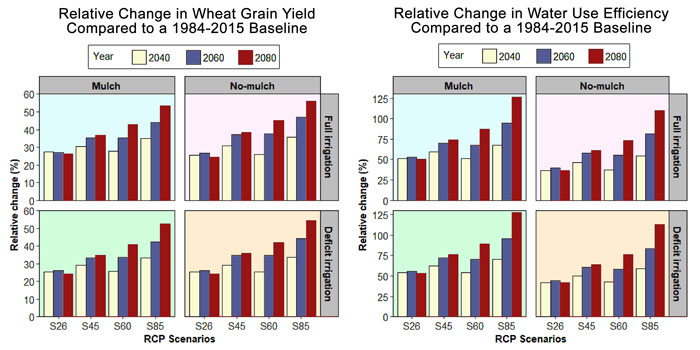| Tweet | Follow @co2science |
Paper Reviewed
Rashid, M.A., Jabloun, M., Andersen, M.N., Zhang, X. and Olesen, J.E. 2019. Climate change is expected to increase yield and water use efficiency of wheat in the North China Plain. Agricultural Water Management 222: 193-203.
In a recent model-based study, Rashid et al. (2019) set out to assess the possible impacts of future climate on winter wheat yields in the North China Plain.
To accomplish this objective, the five scientists applied ensemble projections from 10 general circulation models based four different representative concentration pathway scenarios of future CO2 and temperature (i.e., RCP 2.6, 4.5, 6.0 and 8.5) into the AquaCrop model for climate impact assessment. One benefit of using the AquaCrop model is its ability to calculate changes in crop yields using different water management scenarios (water stresses vs non-stressed and mulch vs no mulch). What is more, it incorporates the CO2 fertilization effect, which is critical in making future crop yield projections.
The end result of the modeling exercise was the production of future estimates of winter wheat yields and water use efficiency in the North China Plain (NCP) for three future time periods (the 2040s, 2060s and 2080s). These estimates are presented in the figure below, relative to a baseline value for the years 1984-2015. As indicated, depending on water management practice (mulch vs no mulch and full irrigation vs deficit irrigation) both winter wheat yield and water use efficiency are expected to increase in the NCP in all future temperature and CO2 scenarios examined. Specifically, Rashid et al. calculate future wheat yields will increase anywhere from 24% to 56%, whereas water use efficiency will be enhanced by 36% to 109%.
The above findings are good news for the NCP, as rising temperatures and CO2 concentrations will help to enhance not only the food security of this region, but its freshwater security as well, as Rashid et al. report a temperature-induced shorter growing cycle combined with a CO2-induced enhancement of water use efficiency will reduce overall irrigation demand in the future. And that is good news worth celebrating!

Figure 1. Relative change in future wheat grain yield (left panel) and water use efficiency (right panel) in comparison to values obtained for a 1984-2015 baseline for the North China Plain. Source: Adapted from Rashid et al. (2019).




